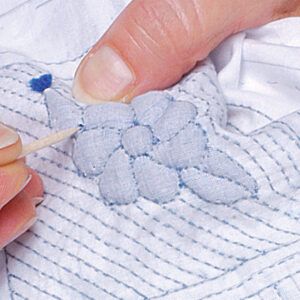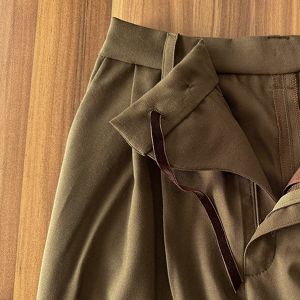I am about to make draperies for several windows and need a larger pressing surface than my ironing board. I have purchased a 36×60″ synthetic pad and plan to staple it to a 3/8″ piece of plywood which I will lay on my cutting table. I can find no information on how to make and use such a board? Does the pad need a cover? Any information would be helpful.
Conversational Threads
Threads Insider
Get instant access to hundreds of videos, tutorials, projects, and more.
Start Your Free TrialAlready an Insider? Log in
Conversational Threads
Highlights
-
Sign up for the Threads eletter
This site is protected by reCAPTCHA and the Google Privacy Policy and Terms of Service apply.See all newsletters -
 Sponsored Content
Sponsored Content
Where to Buy
-

-

-

-























Replies
I assume that the pad is heat tolerant? You don't need a cover, but one would be very nice and make your pressing board last longer. You could use simple undyed muslin (prewash). I would sew velcro and affix it to the bottom of the board with the velcro rather than a staple gun so that you can remove it to wash if needed.
As a result of your suggestion I decided to make the cover removable. However instead of using velcro to fasten it, I made a tight fitting "pillow case" cover, seam in centre bottom. Now I can remove it quickly and easily for washing.
Great idea! Much cheaper than velcro - and easier.
A tight layer of canvas / duck cloth makes a nice press board. I have a full sheet of plywood covered with a single layer of warm n natural and then canvas over that. Just enough to give me a firm surface. Others may like a more cushy base. Make sure whatever you put on there - preshrink it.
Edited 5/9/2005 2:58 pm ET by Jeanne
I am about to make myself a pressing mat of some sort to put on the table by my sewing machine so I don't have to get up and down to the ironing board all the time. You mentioned that you used warm and natural. How is that working for you? Does it stay damp a long time or wick away the moisture when you are pressing. I'm thinking of wrapping a thick pad of warm and natural (folded over a few times) with some muslin rather than putting it on a plywood base. That way I hopefully could roll it lightly to store it.
I rarely use steam so I have virtually no problem with water retention. I like the hard surface. I think you idea should be fine with one addition - add a layer of aluminum foil between your canvas and warm and natural. This will keep the steam off the batting and keep the water away as well. Also make sure you preshrink the batting before you wrap it. Maybe bind like a quilt so all the layers are secured and don't move around.
Jeanne
I once made a cover for an ironing board with muslin and a couple of layers of warm and natural. I needed a cover and just used what I had available at the moment. It worked well on the ironing board since there were holes in the board. The synthetic pads are nicer but cost more. It is good for the steam to be able to go through the cover some away from your work rather than bounce right back at you and the steam needs somewhere to go. I once made the mistake of putting a makeshift pressing surface of the same materials on an old wood top desk for a small project and the steam glued parts of the warm and natural to the desk! So, as common sense would have told me if I had been listening, a vapor barrier is needed between the batting and the table surface. Nancy's notions, http://www.nancysnotions.com , sells a pad like what you are describing. It is under pressing supplies and is called an ironing blanket. Maybe it can give you an idea for making your own.
Thanks for the info. Both you and Jeanne make good points about the steam. I thought I would just use what I had on hand, but maybe I should rethink. I like Nancy's blanket. I live in Canada so will see if I can find it here (hate paying duty). I really need to figure out what exactly I am going to press on it too and maybe there will be a better solution. My new sewing room just doesn't give me space to keep my ironing board near my machine. I thought I would be super efficient! (I can always dream!)
The regular ironing boards do eat up a lot of space, don't they. What about one of those smaller table top ironing boards? I have one that I used to use in a dinky sewing area once. They are inexpensive at the K-mart type stores. The tapered end and the little legs that lifted it up off the table were often useful.Just be creative with what you can use for making the ironing mat. It is surprising what one has around the house if one rethinks the usual purpose of things!
Also, don't overlook the possiblity of putting your ironing board acroos the room, but being able to "scoot" over there in your chair on wheels. I keep my board at a lower position, and iron sitting down.nancy
I recently made a pressing board using 3/8" thick ply wood covered with a blocking/work table pad and an old sheet which I stitched like a tight pillow case so it can be removed for washing. Pad can be purchased from Ce Podolak through her company Material Things, based in Vancouver. At $39.00 Cdn, it's well worth the price. My finished board measures about 30 x 54. I lay it on my cutting table and use it for pressing large items such as draperies, fusing interfacing etc. It's desirable for the steam to drawn through the pad, not reflected back.
Patty Jo, you hit the nail on the head. This is the cutting table configuration favored by Audrey Childress (see discussion thread). Cecilia Podolak evidently is carrying the covers now (they were unavailable for quite a long time).
Audrey manufactured, marketed and sold these "cutting boards." They consisted of a sheet of plywood (hers were usually pretty thick), topped with two layers of Army blankets (which she would acquire at Army surplus stores), a layer of heavy muslin, then the gridded cover. The grids are in one-inch increments. This will assist in cutting and blocking on straight of grain and for quick measurements at the table without the necessity of using a tape measure. They were quite heavy and I am still using one of her old ones; it's about thirty years old now. I have had to re-cover it only once.....
Let me add that, since I used to profesionally fabricate custom draperies, duvets, pillows, bedskirts, comforters and the like, I had a larger table made and simply stitched two covers together where necessary to give me an eight-foot table by about six feet wide. (I'd have to go measure it to give you the exact measurements, since I don't remember.) What a dream!
Edited 6/23/2005 2:55 pm ET by DONNAKAYE
Edited 6/23/2005 2:58 pm ET by DONNAKAYE
Hi, I am enjoying reading all of the messages; they are so informative. I just wanted to add that when I made a pressing board a few years ago, I used gingham with 1" squares for the cover. This has come in handy many times for measuring things as I press.
My cutting table is also a pressing surface, 8ft.x 54" plywood with ceiling tiles over that (for pins to stick into) then according to a THREADS "tip" I used washed wool scraps to make 1/2" thick to wick away moisture, then over that 1/2"-5/8" cotton knit for padding as well as wicking. Over that I stapled an old sheet to just hold all layers down tightly. The top cover is pre-washed cotton duck that I glued a extra long tape measure down each side lengthwise. It's high too and I never get back strain from cutting anymore!
This post is archived.